October 31, 2021 – Volume 23, Issue 10
In This Issue
-
Flanigan’s Eco-Logic: Fall in Aspen
-
Hertz Plans to Buy 100,000 Teslas
-
McKinsey Employee Concerns
-
The Greenest Colleges
-
Transcontinental Wind Delivery
-
The World’s Largest Battery
-
Microgrids: The EcoMotion Challenge
-
The NetPositive Podcast Updates
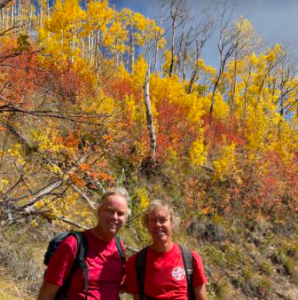
Flanigan’s Eco-Logic: Fall in Aspen
Two great hikes this time in the mountains of Colorado. The first to Cathedral Lake with daughter Skye. It’s a favorite of ours. The sky is a bit ominous. Big clouds. It’s been raining; there’s snow in the mountains. We rule out hiking to Electric Pass at 13,635 feet. That’s a high and dangerous altitude given this weather. The last days of fall.
Up Castle Creek through vibrant fall colors. Aspen trees in swaths of gold with flares of orange. Big mountains; rocky mountains. We turn-off just before the Pine Creek Cookhouse. The Cathedral Lake trailhead begins at 9,880 feet. We begin the “stiff hike” up the Pine Creek Valley, its creek tumbling down the mountain. My sea-level body struggles. I am not acclimated, huffing and puffing and taking many breaks, recharged by the views and majesty of the mountains. We look up to massive avalanche chutes.
Strenuous it is, but soon enough we’re heading up the trail’s signature switchbacks. That means we’re near the lake. It’s a steep pitch. The switchbacks are short, up a narrow incline. There are rock walls on either side. After the last switchback, we crest. There are clumps of snow on the ground. It’s chilly in shorts. As we near the lake it begins to snow. A flurry!

Cathedral Lake is nestled in a dramatic cirque beneath rugged peaks. The lake is at 11,866 feet. The serenity of this huge body of water surrounded by soaring mountains is divine. We’ve got the lake to ourselves right now. We eat granola bars and take pictures. It’s a little too cold and wet to hang out. Another party arrives and hoots and hollers, echoes resound off the cirque that provides a cathedral of granite… sending sound waves back with remarkable clarity.
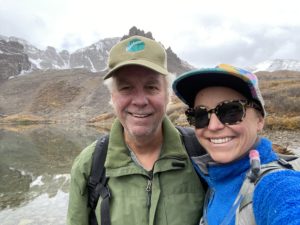
Sure is easy going down hill! We encourage others heading up. Back in our wheels, we follow the creek downvalley, admiring more fall colors. In town, we hot tub at the base of Tiehack, warming up, soothing the muscles, enjoying that great hiker’s feeling of accomplishment.

The next morning Skye and Jake and I head into town in two cars. Through town, past the post office, over the river and up, up, up the slopes of Red Mountain. We pass swanky homes with killer views. Higher and higher up until we’re on dirt roads and we work our way into the Hunter Creek Valley. There we drop a car at the end of our planned Sunnyside trail loop. We hit the farmers market for breakfast burritos and java.
Out of town on the west side, we head down Cemetery Lane, cross the bridge and head left up the McLain Flats Road. Parking on the left; trailhead to the right. We meet brother Bill and BFF Sardo and head up the trail. For the first miles it skirts west. As we rise, the views just get better… the town, the Maroon Bells, the hospital, high school, the busy airport.
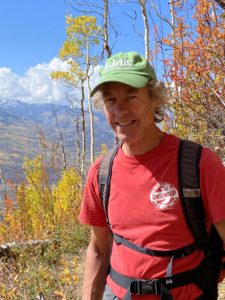
Then we’re above all the Red Mountain houses. Starwood mesa further west, is well below us. The views of Aspen Mountain and the Maroon Bells are postcard perfect. The town of Aspen looks idyllic, nestled at 8,000 feet between Aspen Mountain and “our” mountain for the day, Red Mountain. Blue, blue skies with blustery white clouds. It’s just spectacular, the views unending and enchanted.

Surprised to run into someone that I know. Mike Tierney unicycles towards us. He’s a champion athlete. How can anyone unicycle on a rocky trail like this? Mike also runs Aspen Solar, the area’s leading solar thermal installer. The system he installed for me has been providing free radiant solar heat from three Novan panels for 30+ years. We talk shop.

Sunnyside sweeps west then climbs. We trek and traverse east through aspen forests and then scrub oaks in red fall color and then more aspens. The trail takes us near Red Mountain’s peak and then up and over and down toward Hunter Creek. We pass through a pine forest and feel the cold of its hollow. We now have views of the Sawatch Range, noted for its 14,439 foot Mount Elbert, the highest of Colorado’s 58 “fourteeners.”
On the Hunter Creek Valley floor we walk through fields of golden grasses. We take pictures of abandoned cabins, their corrugated roofing rusting but standing the test of time. Imagine living here, mining for silver, and hunting and fishing for sustenance. The car park appears in the distance. A good workout we’ve had; another successful hike. Lots of good discussions and perspective on the trail as always. The day has been both exhausting and refreshing. Thanks to Jake, Skye, Billy, and Sardo.

![]()
![]()
![]()
![]()
Quote of the Week
“The new Hertz is going to lead the way as a mobility company, starting with the largest EV rental fleet in North America”
Hertz Interim, CEO Mark Fields
Hertz Buys 100,000 Teslas
 Hertz rents cars at 12,000 locations in 160 countries. Hertz began leasing electric vehicles in 2011 but only in select markets for premium prices. This week, Hertz announced that it plans to buy 100,00 Teslas for its rental car fleet. The deal is worth ~$4.2 billion. The 100,000 Teslas will make EVs 20% of Hertz’s global fleet. And Hertz wants an option with Tesla to buy 100,000 more.
Hertz rents cars at 12,000 locations in 160 countries. Hertz began leasing electric vehicles in 2011 but only in select markets for premium prices. This week, Hertz announced that it plans to buy 100,00 Teslas for its rental car fleet. The deal is worth ~$4.2 billion. The 100,000 Teslas will make EVs 20% of Hertz’s global fleet. And Hertz wants an option with Tesla to buy 100,000 more.
Since Hertz’s initial foray into renting EVs, Teslas became popular on the peer-to-peer rental network Turo. Industry analysts believe that Hertz is taking steps to make its user experience as convenient as Turo’s. When you rent with Turo, instead of taking the shuttle to the rental agency and waiting in line, you go right to the parking garage, open the car with an app, and you’re off! In the future, your EV could drive itself to the baggage claim, be warm or pre-cooled, seats and mirrors adjusted for you, and your favorite music on!
The bulk purchase was a bold move indeed for Hertz, the Florida-based car rental company that filed for Chapter 11 bankruptcy protection last year. Its new CEO, Mark Fields, came from Ford and has positioned Hertz to take the lead with EVs. Fields has also worked out a deal with Carvana for used car sales, and with Uber. Half of the first 100,000 Teslas will be reserved for Uber drivers who will be able to rent Model 3 Teslas for $344/week with unlimited mileage.
Hertz is reportedly planning to pay nearly the list price for the Teslas. This represents a departure from normal, deeply-discounted, high-volume rental company purchases. An Inside EV article notes that Tesla is “allergic to discounts.” Hertz could have signed with Chevrolet for less expensive Bolts, but apparently Tesla’s prestige and its supercharger network swung the deal.
Since Fields joined Hertz, its stock has doubled. The news of the 100,000 Tesla purchase also sent Tesla’s stock surging. Tesla stock rose by 12% and the company’s valuation topped $1 trillion dollars, surpassing one of Elon Musk’s biggest rivals, Exxon Mobil. Tesla’s value is now more than the 11 largest global auto manufacturers combined. Its value is three times as much as Toyota, the second most valuable automaker. Only a handful of other companies — Apple, Microsoft, Google-owner Alphabet, and Amazon are worth over a trillion dollars.
McKinsey Employee Concerns
 In what has been considered a revolt within the world’s most influential consulting firm, a letter signed by over 1,100 McKinsey employees called for change at the consulting firm. Why? It has been advising many of the most environmentally damaging companies in the world. In its prestigious 95-year history, McKinsey & Company has supported the world’s biggest polluters.
In what has been considered a revolt within the world’s most influential consulting firm, a letter signed by over 1,100 McKinsey employees called for change at the consulting firm. Why? It has been advising many of the most environmentally damaging companies in the world. In its prestigious 95-year history, McKinsey & Company has supported the world’s biggest polluters.
The letter was crafted by a dozen McKinsey consultants and co-signed by 1,100 employees. The authors said that McKinsey’s failure to address clients’ emissions, “poses serious risk to our reputation, our client relationships, and our ability to build a great firm that attracts, develops, excites, and retains exceptional people.” This is a significant opportunity in time for McKinsey. “McKinsey has a moral obligation to take action to influence our clients’ emissions and to show the leadership our stakeholders expect of us.”
“The climate crisis is the defining issue of our generation…. Our positive impact in other realms will mean nothing if we do not act as our clients alter the Earth irrevocably.” New evidence finds that among the 100 biggest corporate polluters over the past half century, McKinsey has advised at least 43 in recent years, including BP, Exxon Mobil, Gazprom, Saudi Aramco, generating hundreds of millions of dollars in fees. Its critics claim that its work with these companies is often not focused on reducing their environmental footprint, but instead on boosting profits and productivity. In 2018, these clients alone were responsible for more than a third of global carbon emissions according to figures from the Climate Accountability Institute, a Snowmass, Colorado non-profit that tracks corporate carbon emissions headed up by our colleague Rick Heede.
McKinsey claims to be committed to protecting the planet. It ha made a commitment to being net zero by 2030… but its footprint is miniscule compared to those of its clients. On April 5, 2020, and in response to the employee letter released in March 2020, McKinsey’s managing partner, Kevin Sneader, stated that the firm’s management shares the employees’ views that the climate issue is the defining issue for the planet. McKinsey will address this issue head-on both internally and externally. “Our aim is to be the latest private-sector catalyst for decarbonization.”
The Greenest Colleges
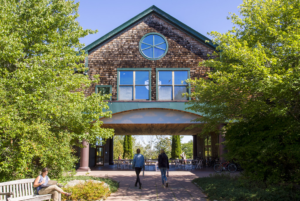 The Princeton Review “Guide to Green Colleges,” 2022 Edition, profiles 420 colleges out of 835 colleges it surveyed. Questions cover more than 25 data points. Of the 420 schools selected, 391 are in the United States, 26 are in Canada, and there was one each from Ecuador, Egypt, and Greece. Note that The Princeton Review is based in New York City and is not affiliated with Princeton University.
The Princeton Review “Guide to Green Colleges,” 2022 Edition, profiles 420 colleges out of 835 colleges it surveyed. Questions cover more than 25 data points. Of the 420 schools selected, 391 are in the United States, 26 are in Canada, and there was one each from Ecuador, Egypt, and Greece. Note that The Princeton Review is based in New York City and is not affiliated with Princeton University.
This year, and for the sixth consecutive year, College of the Atlantic (COA) ranked #1 on the list. COA is located in Bar Harbor, Maine, and was founded in 1969. I visited there several times when Sardo (our Sunnyside hiking partner) was a student there. COA awards bachelors and masters degrees in the field of human ecology. It became the first carbon neutral college in the United States in 2007, and has committed to being fossil-fuel free by 2030.
Princeton Review’s guide has been curated for 12 years. It is a free resource for students who want to live and learn at a green college. It reports that 78% of the 11,133 college applicants responding to its 2021 “College Hope and Worries Survey” said that having information about a college’s commitment to the environment would affect their decisions to apply or attend a school. That was a 12% increase over the 66% of applicants responding to the 2020 survey.
The Top 10:
- College of the Atlantic
- Dickinson College
- University of California at Santa Cruz
- Chatham University
- Bates College
- Emory University
- Cornell University
- Colorado State University
- State University of New York – College of Environment and Forestry
- University of California at Santa Barbara
To see the list of the top 50 colleges, click here!
As a group, the top 50 schools shared impressive statistics. Fully 17% of their total food purchase was from local sources and/or organic; 51% of their waste was diverted from incinerators or solid-waste landfills; 96% offer a sustainability focused undergraduate major or degree; and 100% have a sustainability officer.
Transcontinental Wind Delivery
 OK. Build solar and wind in Africa, and send it to England. Why not? Fully 10.5 GW of solar and wind will be built in Morocco over 579 square miles, and it will supply the United Kingdom with power via subsea cables. Long ones. In fact, the 1.8 GW high voltage direct current subsea cables will each be 2,361 miles long… the world’s longest. “They’ll follow the shallow water route from Morocco to the UK, past Portugal, Spain, and France,” reports ElecTrek.
OK. Build solar and wind in Africa, and send it to England. Why not? Fully 10.5 GW of solar and wind will be built in Morocco over 579 square miles, and it will supply the United Kingdom with power via subsea cables. Long ones. In fact, the 1.8 GW high voltage direct current subsea cables will each be 2,361 miles long… the world’s longest. “They’ll follow the shallow water route from Morocco to the UK, past Portugal, Spain, and France,” reports ElecTrek.
UK-based XLinks is the project developer. The entire project will cost $21.9 billion. The project will consist of 7 GW solar, 3.5 GW wind, and 5 GW/20 GWh of battery storage in Morocco. The transmission will consist of four cables; the first slated to be active in 2027, the additional cables laid in 2029. The project is anticipated to cover 8% of Britain’s electricity needs when complete by 2030.
The power from Morocco will balance generating resources in the United Kingdom; solar from Africa during periods of low offshore wind production in England. Furthermore, solar in Morocco is powerful with irradiance levels 20% higher than in Spain, and double those found in the United Kingdom. On the shortest day of winter in England, Morocco has ten hours of sunshine.
The World’s Largest Battery
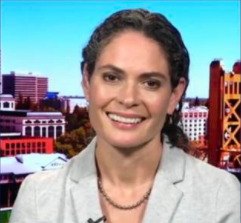
Bernadette Del Chiaro, Executive Director of the California Solar and Storage Association
A 300 MW energy storage system at the Moss Landing power plant in Monterey County, California has been considered the world’s largest energy storage facility. But the Executive Director of the California Solar and Storage Association, Bernadette Del Chiaro, paints a different picture: When you tally the capacity of consumer-owned energy storage systems within California investor-owned utility service territories, the result is a 721 MW virtual power plant.
And the pace of adoption of consumer owned storage is fast. Since August 2020, 300 MW of energy storage has been installed in California. That’s a clip of 20+ MW a month. So far, there are 62,000 energy storage installations at home and businesses throughout the state. Fully 70% of the batteries are solar charged.
Del Chiaro notes also that the 300 MW unit at Moss Landing has been offline for months due to an “overheating incident.” While she advocates for more large-scale storage like Moss Landing, she’s pushing hard for consumer-owned systems too. “We need a lot of both.” The smaller the systems, the more of them that there are, the more resilient. To get both big and small storage she maintains that we need policies like net energy metering and programs that compensate consumers handsomely for discharging their batteries when called upon to do so. “All hands on deck!”
Microgrids: Our Challenge at EcoMotion
 This is the tenth in our ten-part series on microgrids. Let’s end up discussing the challenges and opportunities related to our current work building microgrids in California. Teaser… they must be carbon-free and fully financed!
This is the tenth in our ten-part series on microgrids. Let’s end up discussing the challenges and opportunities related to our current work building microgrids in California. Teaser… they must be carbon-free and fully financed!
We began the series by defining microgrids, their history and their now ever-so-popular ability to island from the grid and provide resilience in the event of a grid outage. The series delved into microgrid components… solar, storage, and controls. We checked out case studies in far-flung places like the Bronx and Mendocino County. We described EcoMotion’s first microgrids in Monterey County, telling the Santa Rita story. We focused on critical loads. Another article featured giving batteries “a day job.” One article highlighted potential synergies — and compromises — with integrated generators. We delved into interconnection and the state of microgrids from a macro and regulatory perspective with Peter Asmus.
Right now, EcoMotion is helping to develop microgrids on behalf of two Community Choice Aggregators (CCAs) here in California. The goal is energy-resiliency. For Clean Power Alliance (CPA), we have evaluated over 120 sites in over 20 cities for carbon-free energy resilience. Cities nominate sites that they would like to see “hardened.” We’re looking for sites that meet our “ideal site checklist” of 12 parameters, for instance, significant load that can be offset with significant solar. We dig into load profiles and interval data. We model systems. In cases, solar generates savings when coupled with a rate shift… savings that we redirect to batteries and controls. The financial equation includes modest savings from peak clipping and arbitrage.
When a site looks good, our engineering team digs in onsite. We begin with the electrical switchgear: Is it sufficient to land solar + storage? Does it need to be replaced? We use single lines to determine where the critical loads are and how they are wired. For each site, we explore subpanels, and smart panels that allow for critical load and full solar configurations. (When the sun is shining, many of our sites will be able to power much more than their critical loads.) Our team examines structural and roofing conditions, conducts shading analysis, and considers conduit runs. We look at spatial opportunities for solar-ports and where storage can be located.
For each site, we build a dossier. We capture photos and videos in an app called Fulcrum, which also houses drawings and data. We write a four page “Site Narrative” that provides an overview of each site, the system planned, the loads to be backed up, and thus the use case at hand. In the coming weeks, we’ll have more than 20 sites ready to go, assembled into a portfolio to be taken to market. Just like a solar system fully financed through a power purchase agreement, we’ll be reaching out to our primed network of suitable developers that will own and operate all the microgrid equipment for the next 20 years.
East Bay Community Energy (EBCE) serves 14 cities and unincorporated parts of Alameda County. These 15 member agencies want resilience in public buildings… in some 300 public buildings. So far, our work with EBCE has focused on two cities’ public buildings, Berkeley and Hayward. For these evaluations the EcoMotion solar team is joined by Point Energy Innovation’s engineers, KPFF structural engineers, and Blue’s Roofing experts. We’re doing deep dives at each site, developing a roadmap for making these facilities functional during grid outages.
For both CCA projects, EcoMotion’s job is to ready a portfolio of energy-resilient buildings to take to the market. What will these microgrid systems cost? How much will they save? Can we get energy resilience without incurring additional costs? That was the case at Santa Rita. Or will certain sites bear a cost premium with the resiliency adder? Yes, EcoMotion can find sites that can switch from being totally dependent on the grid, to having microgrid capabilities, at no additional cost. But these are choice sites that meet many ideal site parameters and that are eligible for rate changes. Microgrid prices will go down, but in most cases energy resilience will bear a cost. How much is a design issue that we will continue to report back to you.
The NetPositive Podcast Updates
- The past edition of EcoNet News, Volume 23 Issue #9 is now available
- This issue of EcoNet News, Volume 23, Issue #10 is also available in podcast format
- The Net Positive Podcast: A Conversation with Phyllis Currie, Chair of the Midcontinent Independent System Operator

All New! Live “Crash Courses” with Ted Flanigan Hosted by Sierra Flanigan:
- The NetPositive Podcast: Live Crash Course on Energy Storage with Ted Flanigan, hosted by Sierra Flanigan
- The Net Positive Podcast: Live Crash Course on Microgrids with Ted Flanigan, hosted by Sierra Flanigan
Check out and subscribe to The NetPositive with Ted Flanigan on Spotify, Apple, and Google.
Episodes include Convos (Conservations and Crash Courses), the News (EcoNet News), and Uni (the EcoMotion University).
